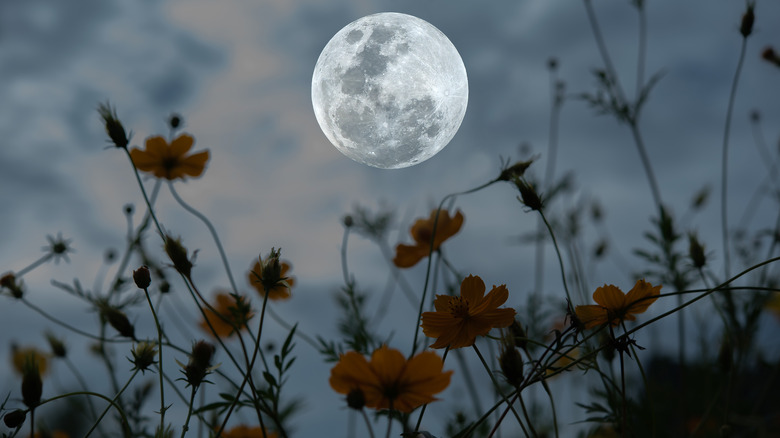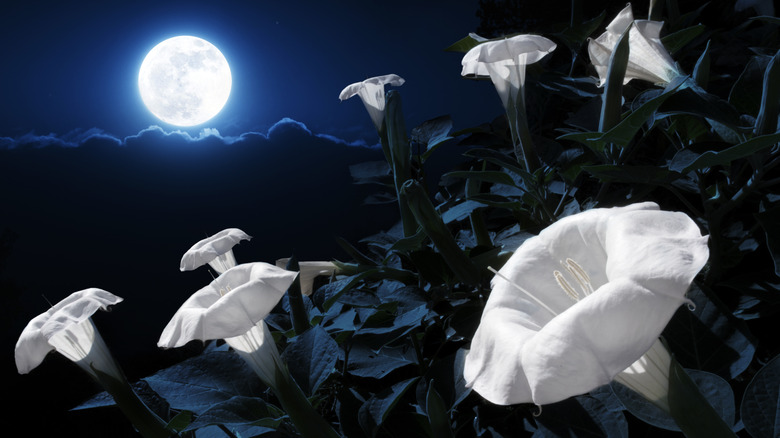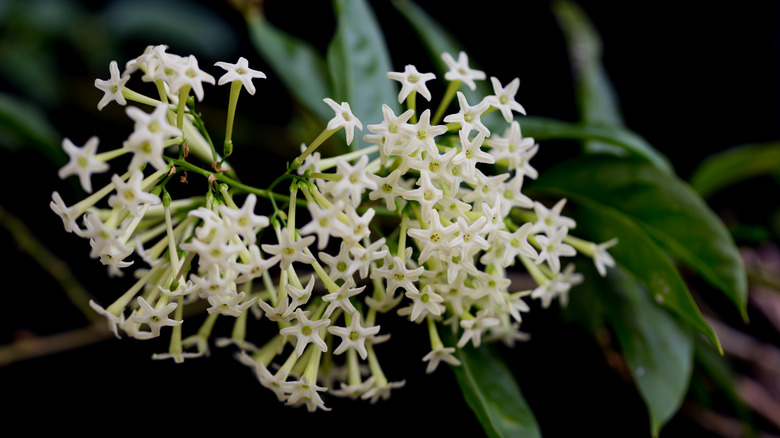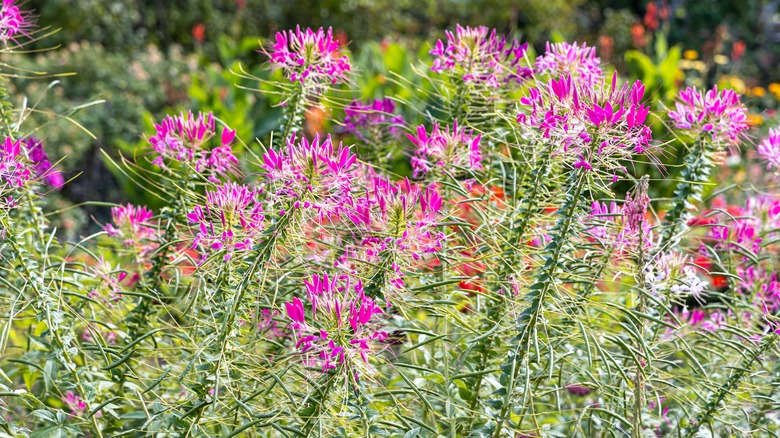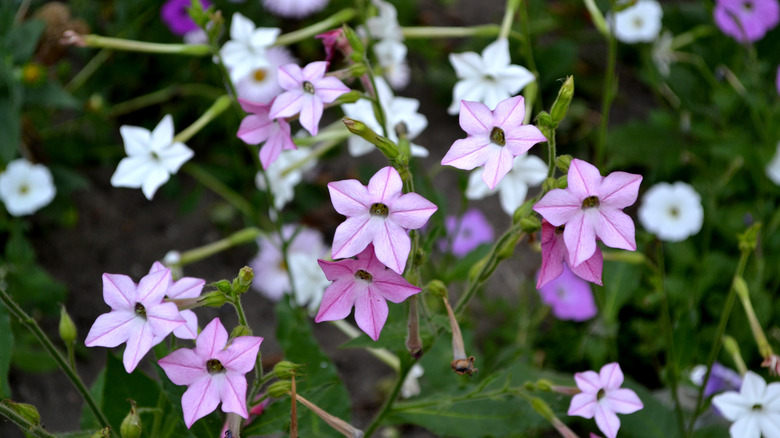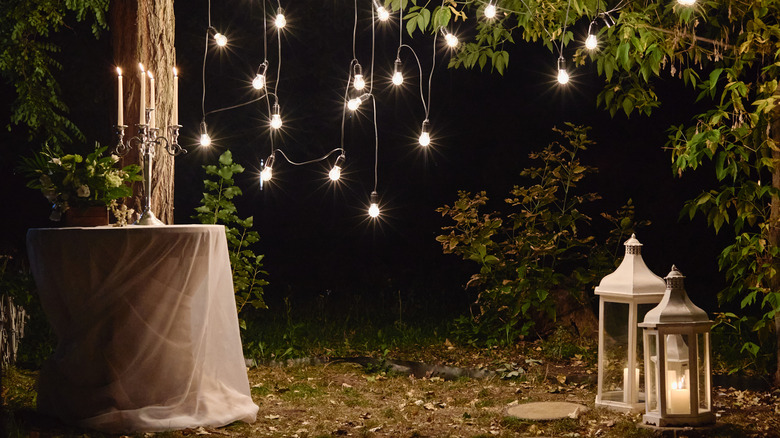How To Create A Moon Garden, The Newest Gardening Trend
Moon gardens are as mystical as they sound — gardens that have been carefully designed with flowers that bloom in the moonlight. Gardening Know How suggests that moon gardens are a great source of relaxation, particularly for enjoying the peaceful quiet and beauty of your stunning nighttime garden after a long day. There is no one right way to design a moon garden, as long as they include night-blooming flowers like moonflowers, petunias, or night-blooming jasmine, just to name a few. They should also be planted in an area that can receive full, unfiltered moonlight.
Realtor.com says there are plenty of ways to go about actually creating your garden, some people even choosing to design them in the shape of a crescent moon. Some people prefer to only incorporate white and silver tinted flowers that reflect the light of the moon, and some like to incorporate colorful blooms. Some night-blooming flowers even release pleasant scents in the light of the moon, and others attract night pollinators like moths and bats, offering a unique opportunity to experience nocturnal wildlife. Other non-flora elements you can include in a moon garden include wind chimes, water fountains, etc.
Plant moonflower vines
One of the more popular flowers to incorporate into a moon garden is, as the name suggests, a moonflower. This flower is related to sweet potato vines and morning glories and is a climbing vine that can be beautifully grown on a trellis or fence, per Gardening Know How. They can be found in white shades to reflect the bright moonlight or purple for a deeper, more mystical feel. Regardless of the color, they are also popular for releasing a sweet scent as they unfurl and begin to bloom in the late afternoon.
They are most suited to warmer, subtropical climates, like USDA hardiness zones 10 to 11, if you want to grow them as perennials. That being said, they can easily be grown as annuals in colder zones. Since they are vines, they need a trellis, post, pole, or other item to climb and can grow up to 20 feet tall. The plant is also toxic, so growing this way can prevent wildlife and pets from a serious mishaps.
Since these flowers are night bloomers, assure they have as much access to moonlight as possible, which means they should have plenty of sunlight access. Just be sure they're not exposed to harsh, hot sun that can scorch the leaves. Feeding with a high phosphorus fertilizer diluted to half strength will further help encourage blooms. Other than that, basic care includes watering regularly and pinching off dead or straggly blooms for both plant health and aesthetic value.
Add some night-blooming jasmine
Night-blooming jasmine, also commonly referred to as lady of the night or queen of the night, is, as the name implies, a flower that blooms at night, and as such is perfect for adding to your moon garden. They actually aren't a jasmine relative, according to Masterclass, but a member of the Solanaceae, or night-shade, family, which includes tomatoes and peppers.
This flowering plant grows in a shrub, and should be planted with anywhere from 4 to 6 feet of space between it and other plants, which will allow the roots to adequately spread. Again, they are more equipped for warmer climates, hardiness zones 9-11, for perennial growth, but can be grown in containers or as annuals for colder climates. Night-blooming jasmines emit a sweet scent as they bloom, making them a great addition to your moon garden regardless of weather.
As for care, ensure the plant is exposed to at least six hours of direct sunlight, though they can survive partial shade. Water the plant frequently, a few times a week, especially as they are beginning to root, cutting back to only when essential in the winter. Fertilizing should be done monthly with young plants, and once a year with mature plants. Night-blooming jasmine is toxic, so be careful not to plant it somewhere your pets, children, or wildlife can easily get into.
Incorporate cleomes
Another great option for moon gardeners are cleomes, or spider flowers, advises Realtor.com. One unique aspect of this flower is that it blooms both in the day and night, making it quite versatile. This flower also comes in shades of pink and purple, as well as white, offering variation in your moon garden color palette. It gets its nickname from the long stemmy tendrils that grow from the flower, resembling the legs of a spider, which can add an air of mystique to your moon garden.
People living in colder climates should be a little cautious before committing to cleomes, though, as The Spruce warns, they can only be grown as perennials in USDA hardiness zones 10 and 11 and are a little slow to bloom. This can be overcome in a few ways for colder climate gardeners, though, such as growing them in containers that can be overwintered, purchasing a pre-grown plant from a nursery that already has blooms, and frequently watering to quickly establish the plant, as well as deadheading to encourage new blooms.
Other than frequent watering when younger (mature plants are drought resistant), the only other care involves making sure they get full sun, warm temperatures (75 to 80 degrees minimum during the day and 60 to 68 degrees minimum at night), and high humidity (preferably 90%). They do not need fertilizer, and they are remarkably pest resistant. They are also non-toxic, according to the ASPCA.
Top it off with fragrant flowering tobacco
Flowering tobacco, also referred to as nicotiana, jasmine tobacco, sweet tobacco, and winged tobacco, is a species of ornamental tobacco that releases a strong fragrance at night comparable to jasmine, says Better Homes & Gardens, making them another excellent addition to a moon garden. The flowers of the plant can be found in yellow, white, pink, red, and yellow, according to The Spruce, and can be grown as perennials in zones 10 and 11 and annuals in colder areas. They prefer not only warm weather but warm soil as well, so don't plant in the cold and soggy spring soil found in colder climates, as the plant can easily develop root rot. To be safe, wait to plant until two weeks after the last frost.
Nicotiana requires at least six hours of full sun a day, so planting in an area that receives both full sunlight and moonlight is ideal. Not only will this help your plant thrive, but the moonlight will reflect off the lighter-colored flowers, creating a beautiful and magical garden. Flowering tobacco also likes to be consistently moist and should be watered frequently, roughly whenever the top inch of soil dries out. Fertilize right after planting to help the plant establish, and then feed monthly. This plant is also toxic, so be careful not to plant it somewhere pets and children can easily get into it.
Don't forget the décor
While the main focus of a moon garden are the flowers that bloom at night, often releasing a sweet and potent fragrance as they unfurl and reflect the moonlight, they aren't the only thing that goes into this magical garden trend. There are many directions you can go in — mystical, fantasy-inspired, and even a little haunting. Regardless of your design preference, the addition of garden decor can help amplify the look you're going for.
Garden Design has a few recommendations for moon garden design, one of them being using light-colored hardscaping to catch and reflect the moonlight. This includes white pebbles, marble chips, and flagstones, as well as white lattices and other gardening elements. Shades of silver will also look wonderful in the moonlight. Using white stones and gravel for a pathway is also a great idea — not only will it look great in the reflection of moonlight, but it will be easier to see at night and, therefore, safer.
Speaking of safety, lighting is another aspect that can really enhance your moon garden. Don't go overboard with artificial lights, as they may negatively impact your night blooms, but fairy lanterns, string lights, and solar lights that light up at night can all look wonderful in your moon garden. Other great ways to create ambiance in your moon garden include adding a fountain, koi pond, waterfall, or wind chimes. The possibilities are endless.
